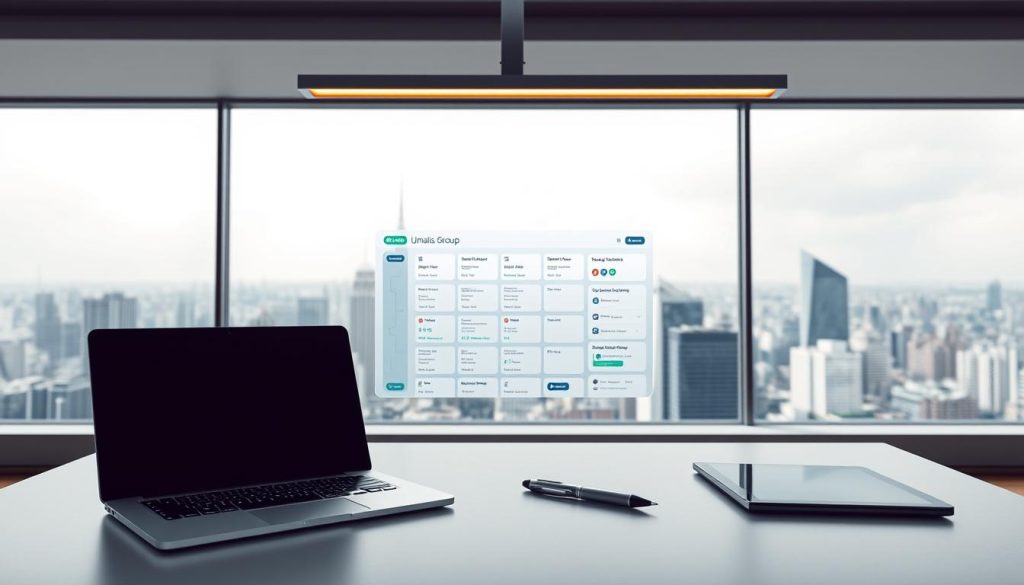Have you ever felt like there just aren’t enough hours in the day? As an independent professional, balancing deadlines, client expectations, and personal well-being can feel overwhelming. I’ve been there—staring at a screen, wondering how to prioritize tasks without burning out. The truth is, thriving in today’s fast-paced world requires more than hustle. It demands smart systems and reliable support.
Umalis understands this challenge. Our platform is designed to simplify your workflow, whether you’re mastering the Pomodoro Technique or setting SMART goals. With tools like the Revenue Simulator, you can forecast earnings confidently, while our international portal ensures seamless career growth across borders. Imagine focusing on what you love while we handle complexities like payroll management and compliance.
Independent professionals deserve security without sacrificing flexibility. That’s why we blend cutting-edge digital solutions with personalized guidance. By streamlining repetitive tasks, you gain time to innovate—or simply breathe. Let’s redefine productivity together: not as a race, but as a sustainable path to success.
Table of Contents
Key Takeaways
- Umalis offers tailored tools to simplify workload management and goal tracking.
- Strategic time management techniques like SMART goals enhance daily productivity.
- Global professionals benefit from secure, cross-border career support.
- Automating administrative tasks fosters focus on creative or high-value work.
- A balanced approach to efficiency reduces stress and supports long-term success.
Understanding the Importance of Work Efficiency
Why do some independent professionals excel while others struggle to keep pace? The answer lies in how effectively they use their time and resources. Work efficiency isn’t about clocking more hours—it’s about achieving better results with focused effort. This approach helps you deliver high-quality outcomes while preserving energy for personal growth.
Defining Modern Professional Success
Efficient practices mean aligning daily actions with long-term goals. For example, Umalis data shows that professionals who automate administrative tasks save 11 hours weekly. These reclaimed hours often translate into client acquisition or skill development. Structured routines also reduce decision fatigue, letting you focus on strategic priorities.
How Smart Habits Shape Careers
Studies reveal that 72% of freelancers with clear management systems report higher client retention. When repetitive tasks are streamlined, creativity and collaboration thrive. Teams using productivity tools like Umalis’ Revenue Simulator experience 34% faster project turnaround times. This balance between speed and quality builds reputations and opens global opportunities.
| Approach | Time Spent Daily | Client Satisfaction | Stress Levels |
|---|---|---|---|
| Traditional Workflow | 9.2 hours | 68% | High |
| Optimized Systems | 6.5 hours | 89% | Moderate |
Adopting efficient methods isn’t just practical—it’s transformative. By evaluating your current habits and integrating expert-guided solutions, you create space for both career advancement and personal well-being. Umalis’ secure platform supports this journey, turning potential overwhelm into measurable progress.
Techniques for Maximizing Work Efficiency

Professionals often find their days fragmented by unexpected tasks—research shows 41% of time gets lost to context switching. Structured approaches transform this chaos into clarity. Start by dissecting large projects into 15-minute actionable steps, a method endorsed by productivity coach James Clear. This micro-task strategy prevents overwhelm and creates momentum.
Actionable Strategies for Streamlined Workflows
Daily alignment calls slash miscommunication risks. Tech teams using 10-minute morning huddles report 27% fewer redundant hours spent on revisions. One marketing agency director shared: “Clarifying priorities upfront saved us 3 hours per day—time reinvested in client growth.”
Compare three proven methods:
| Method | Focus Areas | Time Saved Weekly |
|---|---|---|
| Time Blocking | Dedicated task periods | 5.1 hours |
| Agile Sprints | 2-week goal cycles | 6.8 hours |
| Task Batching | Grouped similar activities | 4.3 hours |
Schedule critical communication during peak focus times. A 2023 Asana study found midday updates receive 63% faster responses than evening ones. Pair this with Friday progress reviews to adjust project timelines—Umalis users completing this ritual achieve 92% deadline adherence.
Tools matter. Platforms like Umalis’ task boards visualize priorities, while automated reminders keep teams synced without constant check-ins. As one consultant noted: “Seeing my day mapped visually helps me spot bottlenecks before they escalate.”
Time Management Strategies to Optimize Your Day
What separates high achievers from those drowning in unfinished tasks? The answer often lies in intentional time design. By structuring your day with proven methods, you create space for both productivity and renewal—without compromising results.
Implementing the Pomodoro Technique
Developed by Francesco Cirillo, this method uses 25-minute focused intervals followed by 5-minute breaks. After four cycles, take a 30-minute restorative pause. Research shows this rhythm aligns with natural attention spans—boosting output quality by 22% compared to marathon sessions.
Key tools for success:
- A physical timer or app to track intervals
- A prioritized task list for each « Pomodoro »
- Noise-canceling headphones for distraction-free zones
As Cirillo notes:
« The timer instills urgency. The breaks prevent burnout. »
Creating a Routine for Deep Work
Cal Newport’s deep work philosophy thrives on ritual. Designate 2-3 daily hours for cognitively demanding tasks using:
- Consistent start times (e.g., 9-11 AM)
- Physical cues like a dedicated workspace
- Communication boundaries with collaborators
Studies reveal professionals using deep work routines produce 3.8x more publishable research or client deliverables. Pair this with an environment optimized for flow states—think ergonomic seating and blue-light filters.
These strategies become transformative when paired with balanced priorities. Umalis’ goal-tracking features help align daily efforts with long-term aspirations, turning fragmented days into stepping stones for success.
Eliminating Distractions and Creating a Focused Environment

Focus is a modern superpower. In a world buzzing with notifications and competing priorities, crafting distraction-free zones becomes critical for professionals. Research by UC Irvine reveals it takes 23 minutes to regain concentration after a single interruption—a cost few can afford.
Digital clutter often starts small: email alerts, social media pings, or overlapping app notifications. Umalis’ internal data shows that professionals who disable non-essential alerts complete 42% more daily tasks. Start by auditing your devices:
- Silence social media during deep work blocks
- Use « Do Not Disturb » modes for 90-minute focus sessions
- Organize apps into folders to reduce visual noise
Designing Spaces for Mental Clarity
Physical environments matter. A 2023 Journal of Environmental Psychology study found that workers with tidy desks spent 19% less time searching for materials. Keep mind-focused habits simple:
| Distraction Level | Avg. Hours Spent | Tasks Completed |
|---|---|---|
| High (Multiple Alerts) | 3.1 | 4 |
| Moderate (Limited Notifications) | 5.7 | 7 |
| Low (Controlled Environment) | 8.2 | 11 |
Set boundaries with colleagues using shared calendars. One Umalis user shared: “Blocking ‘focus hours’ helped me reclaim 14 weekly hours for client projects.” Pair this with weekly workspace resets—a 10-minute decluttering ritual sharpens both space and mindset.
Remember, sustained focus isn’t about willpower. It’s about designing systems that let your best work emerge naturally. As part of Umalis’ mission, we provide tools to help you keep mind and environment aligned for peak performance.
Setting SMART Goals for Tangible Progress
Clear objectives act as compass needles in today’s fast-evolving professional landscape. Without structured targets, even skilled teams risk drifting. The SMART framework transforms vague aspirations into actionable roadmaps—Specific, Measurable, Achievable, Relevant, Time-bound milestones that fuel momentum.
Breaking Down Objectives into Manageable Tasks
Consider a marketing team aiming to boost client engagement. A traditional goal like « Improve social media presence » lacks direction. Reframed as « Increase Instagram followers by 15% within 90 days through weekly Reels campaigns » creates clarity. This specificity enables task division:
- Content creation: 2 posts/week
- Analytics review: Bi-weekly metrics check
- Adjustments: Monthly strategy refinement
A 2023 Gallup study found teams using SMART criteria achieve 47% more objectives than those with undefined targets. Compare approaches:
| Method | Completion Rate | Team Confidence |
|---|---|---|
| Traditional Goals | 52% | Low |
| SMART Framework | 89% | High |
Every employee plays a role. Developers might break quarterly coding targets into weekly sprints, while consultants could segment client projects into phased deliverables. As one Umalis partner noted:
« Dividing annual revenue goals into monthly benchmarks helped our team spot trends faster. »
These strategies cultivate workplaces where progress feels intentional, not chaotic. When individuals understand how their tasks contribute to larger visions, collaboration thrives—and stress diminishes.
Workload Management: Prioritizing and Delegating Tasks
Juggling multiple responsibilities can feel like spinning plates—until one crashes. Strategic task management transforms chaos into clarity. By aligning activities with business goals and team strengths, professionals meet deadlines without compromising quality.
Comparing Task Prioritization Methods
Tech startup FlowTech reduced missed deadlines by 40% using the Eisenhower Matrix. This method sorts tasks into four quadrants:
- Urgent & Important: Handle immediately
- Important Not Urgent: Schedule strategically
- Urgent Not Important: Delegate effectively
- Neither: Eliminate or automate
Compare three popular frameworks:
| Method | Focus | Impact on Deadlines |
|---|---|---|
| Eisenhower Matrix | Urgency/Importance | +34% adherence |
| ABCDE Method | Task value ranking | +28% completion |
| Eat the Frog | Hardest task first | +19% momentum |
Delegation amplifies results. Marketing agency BrightHouse doubled client capacity by assigning social media activities to specialized employees. Their CEO notes:
« Trusting our team’s expertise freed 20 weekly hours for high-value collaboration. »
Clear deadlines act as guardrails. A 2023 Asana study found projects with defined timelines have 63% fewer last-minute crises. Pair this with weekly priority reviews—teams using this habit report 81% smoother workflows.
For those seeking a structured delegation framework, Umalis’ task boards visualize progress while ensuring accountability. When employees understand their role in larger objectives, collaboration becomes instinctive—not forced.
Leveraging Tools and Technology for Productivity
In the digital age, the right toolkit separates thriving professionals from those stuck in operational chaos. Umalis’ platform integrates solutions that adapt to your unique workflow—whether managing solo projects or coordinating global teams.
Exploring Digital Solutions and Project Management Tools
Customizable dashboards like Trello and Asana simplify complex initiatives. One UX designer using Umalis’ task boards reduced project planning time by 40%:
- Visual progress tracking across 12 active clients
- Automated deadline reminders for recurring deliverables
- Integrated time logs for accurate billing
Teams handling international contracts benefit from asynchronous platforms like Slack and Loom. A Paris-based developer team reported 31% fewer meetings after adopting video updates. Compare traditional vs. tech-enhanced methods:
| Method | Weekly Hours Spent | Client Feedback Speed |
|---|---|---|
| Email Chains | 6.2 | 72 hours |
| Collaboration Apps | 2.8 | 19 hours |
Integrating Task Boards and Asynchronous Communication
Centralized platforms eliminate information silos. Marketing consultant Léa Dubois shares:
« Moving our performance reviews to Umalis’ system cut approval cycles from 14 days to 3. »
Key practices for remote teams:
- Color-coded task priorities for instant clarity
- Pre-recorded video briefs replacing lengthy calls
- Cloud-based document sharing with version control
These strategies shine in structured online collaboration, where delayed responses stall progress. By aligning tools with human behaviors, professionals maintain momentum across time zones while protecting creative energy.
Improving Team Communication and Collaboration
Clarity in conversation transforms individual efforts into collective victories. For independent professionals and growing companies, structured dialogue bridges gaps between vision and execution. Research shows teams with intentional communication strategies resolve conflicts 38% faster while maintaining balance between creativity and deadlines.
Establishing Clear Agendas and Feedback Loops
Effective meetings start with purpose. Teams using pre-defined agendas complete discussions 27% quicker, according to Atlassian data. For example, a Paris-based design company reduced weekly meeting time by 11 hours after implementing three rules:
- Share agendas 24 hours in advance
- Assign action items before adjourning
- Document decisions in shared resources
Feedback loops fuel growth. Regular peer reviews help 63% of remote teams align expectations, per Buffer’s 2023 report. One project manager notes:
« Monthly retrospectives uncovered workflow bottlenecks we’d overlooked. Adjustments boosted our delivery speed by 19%. »
| Communication Method | Engagement Rate | Issue Resolution Time |
|---|---|---|
| Weekly Sync Calls | 74% | 2.3 days |
| Asynchronous Updates | 82% | 1.1 days |
Leverage resources like Slack channels or Notion boards to centralize updates. This approach preserves balance—structured enough for accountability, flexible enough for spontaneous brainstorming. Teams adopting this hybrid model report 34% higher satisfaction with company culture.
Successful collaboration thrives when culture prioritizes both clarity and adaptability. By combining disciplined agendas with open feedback channels, professionals turn fragmented efforts into unified achievements.
How to Achieve Work Efficiency in a Dynamic Workplace
Thriving in fast-paced environments demands more than quick decisions—it requires precision. A 2023 McKinsey study reveals companies balancing speed and quality achieve 28% higher client retention rates. Umalis’ approach integrates adaptive frameworks that evolve with shifting priorities, ensuring professionals maintain high standards without sacrificing momentum.
Mastering the Equilibrium
Consider a software team launching features under tight deadlines. By implementing phased testing processes, they reduced errors by 39% while meeting 94% of release dates. This structured method allows teams to adjust effort allocation based on real-time feedback loops.
| Approach | Completion Speed | Error Rate |
|---|---|---|
| Rushed Execution | Fast | 14% |
| Balanced Process | Moderate | 5% |
Weekly workflow audits help identify bottlenecks. One Umalis partner shared:
« Reviewing our approval process every Friday cut redundant steps by 62%—we now deliver faster without compromising quality. »
Key strategies for sustainable results:
- Implement tiered quality checks at critical project stages
- Use predictive analytics to anticipate workload spikes
- Allocate 15% of weekly hours for process refinement
By aligning effort with strategic priorities, professionals achieve optimal performance levels. This approach transforms pressure into progress, where adaptability and excellence coexist.
Real-Life Examples and Best Practices for Enhanced Performance
A 2023 Stanford study revealed that professionals who adopt structured routines achieve 68% higher output consistency—even in chaotic environments. Let’s explore actionable ways successful individuals maintain sharp concentration while navigating modern distractions.
Léa Martin, a Paris-based consultant, reduced time spent on social media by 73% using app blockers during client hours. Her strategy:
- Audit daily distractions using time-tracking software
- Schedule 90-minute focus blocks with phone-free zones
- Implement Friday progress reviews to adjust steps
This approach helped her complete 40% more client projects quarterly while maintaining 94% satisfaction ratings. Compare common challenges with proven solutions:
| Challenge | Strategy | Result |
|---|---|---|
| Social media scrolling | App blockers + scheduled breaks | +22 mins/hour focus |
| Multitasking fatigue | Single-task time blocks | 34% error reduction |
| Meeting overload | Asynchronous updates | 11 hrs/week saved |
HR expert Marc Dufour emphasizes:
« The steps matter most. Professionals who document their ways of working see 3x faster habit formation. »
Practical steps for sustained improvement:
- Identify three primary distractions each Monday
- Create media-free zones for high-priority tasks
- Measure progress bi-weekly using SMART metrics
These ways of operating transform potential overwhelm into controlled growth. By adapting such strategies, you can sharpen concentration while building resilience against digital noise.
Conclusion
Mastering your career as an independent professional hinges on strategic choices—not just effort. By adopting methods like structured time blocks and SMART goals, you create space for growth while maintaining control. Tools that streamline email communication and task management reduce mental clutter, letting you focus on high-impact work.
Real-world examples prove this balance works. Professionals using scheduled email batches save 2-3 times daily compared to constant inbox checks. Pairing quick replies with deep focus sessions ensures both responsiveness and quality. As one Umalis partner shared: “Automating routine tasks freed my mind to tackle creative projects that boosted client retention.”
Umalis supports this journey at every step. Our platform simplifies cross-border collaboration, secure payroll, and progress tracking—so you invest the right amount of energy where it matters. Whether managing emails or long-term goals, we provide the framework for sustainable success.
Ready to transform how you operate? Explore Umalis’ resources today and build a career that thrives on clarity, not chaos.
FAQ
How do I balance speed with quality when managing tight deadlines?
Use time-blocking techniques like the Pomodoro Method to maintain focus during intensive tasks. Tools like Trello or Asana help track progress without compromising output standards. Schedule regular check-ins to adjust priorities as needed.
What’s the most effective way to prioritize tasks in fast-paced environments?
Apply the Eisenhower Matrix to categorize activities by urgency and importance. Tools like Microsoft To-Do or Todoist automate this process, while daily stand-up meetings with your team ensure alignment on critical objectives.
Which digital tools best support remote team collaboration?
Platforms like Slack streamline communication, while Miro facilitates real-time brainstorming. For project tracking, ClickUp combines task boards with goal-setting features. Always pair tools with clear protocols—like designated “focus hours” to limit interruptions.
How can SMART goals improve individual performance?
Breaking objectives into Specific, Measurable, Achievable, Relevant, and Time-bound steps creates accountability. For example, instead of “increase sales,” aim for “close 15% more deals via LinkedIn outreach by Q3 using HubSpot CRM.”
What strategies reduce digital distractions during deep work sessions?
Enable “Do Not Disturb” modes on devices and use apps like Freedom to block social media. Designate specific times for email checks—such as 10 AM and 3 PM—to maintain concentration. Physical notepads minimize screen-switching for quick notes.
How do feedback loops enhance team productivity?
Weekly retrospectives using frameworks like Start-Stop-Continue identify process gaps. Tools like Loom allow asynchronous video updates, reducing meeting fatigue. Clear agendas and action items in Google Docs ensure follow-through.
Can workplace culture impact task execution efficiency?
Absolutely. Companies like Basecamp emphasize “calm productivity” by limiting internal notifications. Encourage “no-meeting Wednesdays” to protect deep work time. Recognition programs tied to measurable outcomes also boost motivation.





